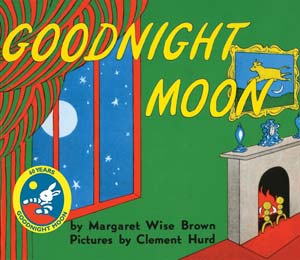Receptive language, Expressive language
Toddlers participate in a book sharing focused on saying goodnight.



[Invite several toddlers to join you to read a book. Show the cover of the book. Point to features of the cover picture as you describe each.]
 Our book tells us about a bunny going to bed. It is nighttime. It is time for the bunny to sleep.
Our book tells us about a bunny going to bed. It is nighttime. It is time for the bunny to sleep.
[Point to the moon.]
This is the moon. The sky is dark. Look at the stars in the sky.
We can say goodnight when it is time to go to bed. Let’s say “goodnight” together.
[Encourage the toddler to say “goodnight” with you. You might wish to wave when you say “goodnight.”]
Our book says “goodnight” to lots of different things. Some parts of our book are silly!
[Use the following strategies to engage the toddler in the book:
Our book said goodnight to lots of different things. Some of the pictures were silly!
The bright pictures and rhyming text make this book an enjoyable experience for toddlers. Toddlers will be familiar with many of the items shown in the pictures. Some toddlers may say the names of some objects, and others may find and point to familiar objects you name.
Extra support
Enrichment
Receptive language, Expressive language
A toddler participates in a shared book reading with an opportunity to join a caregiver in saying a key word repeated in the story.



 Invite a toddler to help you read Goodnight Moon by saying some of the book’s words with you. Use the strategies suggested in Option 1 plus opportunities for the toddler to repeat or say with you “goodnight” each time it appears in the book, including its title. You may wish to develop a simple cue for when we say “goodnight,” such as raising your eyebrows and nodding, slightly raising a finger, or lightly touching the toddler’s arm.
Invite a toddler to help you read Goodnight Moon by saying some of the book’s words with you. Use the strategies suggested in Option 1 plus opportunities for the toddler to repeat or say with you “goodnight” each time it appears in the book, including its title. You may wish to develop a simple cue for when we say “goodnight,” such as raising your eyebrows and nodding, slightly raising a finger, or lightly touching the toddler’s arm.
Acknowledge the toddler’s contribution to the book reading when you conclude the session. Example: “You helped me read our book! You said the word “goodnight.” We had fun reading this book together.”
Some toddlers may promptly begin saying “goodnight,” some toddlers may begin saying “goodnight” with you partway through the story, and others may prefer to listen only. It is helpful to accentuate the book’s rhyming words and “goodnight” each time it is included in the book text.
Extra support
Enrichment
Receptive language, Expressive language
A toddler participates in a shared book reading with an opportunity to point to and say the name of familiar items in pictures.



 Invite a toddler to help you read Goodnight Moon by pointing to and saying the names of things in pictures. Explain that the book says ‘goodnight’ to many different things. Encourage the toddler to point to and repeat the names of items the moon recognizes with a “goodnight.” Begin with “goodnight moon.” Say the text, invite the toddler to point to the moon, and repeat “goodnight moon.” Demonstrate if needed. Continue this approach with all pages. Make this a fun and lighthearted activity, and provide assistance if the toddler has difficulty finding the object.
Invite a toddler to help you read Goodnight Moon by pointing to and saying the names of things in pictures. Explain that the book says ‘goodnight’ to many different things. Encourage the toddler to point to and repeat the names of items the moon recognizes with a “goodnight.” Begin with “goodnight moon.” Say the text, invite the toddler to point to the moon, and repeat “goodnight moon.” Demonstrate if needed. Continue this approach with all pages. Make this a fun and lighthearted activity, and provide assistance if the toddler has difficulty finding the object.
Positively acknowledge the toddler’s participation when you conclude the session. Example: “You helped me read our book! You said “goodnight” and pointed to many things in our book. We had fun reading this book together.”
Some toddlers may prefer to point to items named in the book text but not repeat the names of items. Other toddlers may say names but not point. Both approaches are beneficial. If a toddler prefers to listen only, the strategies suggested in Option 1 may be more appropriate.
Extra support
Enrichment
Materials Needed: Goodnight Moon by Margaret Wise Brown (oversized version if available), Goodnight Moon picture cards
The picture cards for this activity may be purchased, printed from online sources, or handmade. Place the book open on a low table with the picture cards. Invite toddlers to look at the picture cards, one at a time, and find the same picture in the book. Encourage toddlers to name or describe what they see in the picture. Toddlers will likely need support with this task. Limit the number of cards you make available and rotate them periodically.
Materials Needed: Goodnight Moon by Margaret Wise Brown (oversized version if available)
Using an oversized version of the book can make it easier for children of different ages to look closely at details of pictures. Consider using a combination of the strategies suggested in Options 2 and 3 to share the book, depending on the ages and book experiences of children in the gathering. The contributions of older children can enhance young toddlers’ understandings of pictures and words. Infants may enjoy holding a Goodnight Moon board book during the activity.